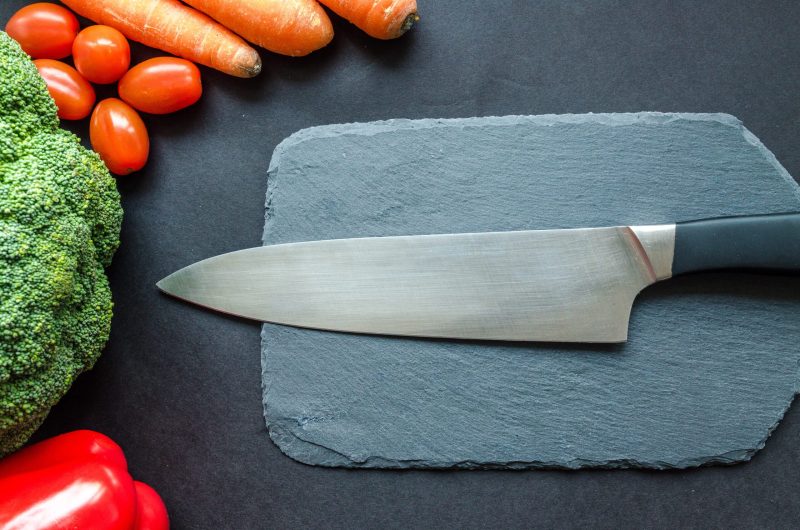You may be a seasoned cook, but do you know all there is to know about the single most important tool in the kitchen? Your knife, just like the ingredients that you use, can make or break the quality of your food. Sharpness is key with such an important kitchen tool. And over time, quite a few different myths have built up around keeping your knife sharp.
1. The Honing Rod Is The Best Tool For Sharpening

When you purchase a set of knives, sometimes a honing rod is included to help you maintain their sharp edges. However, you could be doing your kitchenware more harm than good. Though a honing rod works wonders for assisting with resharpening your knife, it will never truly be as keen as it once was out of the box if you proceed that way. Instead, try a sharpening stone, also known as a whetstone, which actually shaves off a little of your knife to reveal a sharp new edge each time, unlike the honing tool that basically only adjusts and centers your knife’s edge. Though both are great tools to incorporate in the kitchen, the honing rod, isn’t actually sharpening your knife as well as you think.
2. Any Cutting Board Will Do

Cutting boards are made from various types of material, from plastic to metal. Some cutting boards are even utilized as serving trays for a variety of appetizers and snacks, despite their recent health concerns. However, a softer surface works best. Steer clear of glass or ceramic cutting boards which can cause the blades of your knives to bend and become dull. Instead, opt for bamboo or wood varieties, which helps you to easily grip the food as you slice it. Wood cutting boards also enable minimal slippage as opposed to a hard edge, allowing for a safer experience each time. Instead, save your hard-surfaced boards for kneading a dough.
3. Knives Are Dishwasher Safe

Alena Pl/Shutterstock
Though the dishwasher saves time like no other appliance, when it comes to your knives, it’s best not to take a chance. A quality dishwasher is able to clean dishes at 120 degrees, however, this can actually strip away at your knives, leaving them dull or ragged. Additionally, placing sharp knives in the dishwasher can lead to accidents if you aren’t careful when reaching down to grab something. Just hot water and mild soap is all you need. Make sure to wash immediately after use to avoid corrosion and rust. Be sure to take precautions even when cleaning your knives manually and avoid dumping them in the bottom of the sink. Instead, rinse them one at a time, wipe and put away.
4. Expensive Is Always Better

Not sure whether or not to invest in an expensive or inexpensive knife? The price of a knife can range from $10-$1,000, depending on your budget. While you can obtain quality blades that last or years with an expensive knife, inexpensive ones tend to wear and tear more easily and within a shorter time frame. All knives are actually sharp when you first purchase them. However, what it really comes down to is the ability to maintain the knife’s sharp edge because it’s the bevel, angle and overall handling that really determines a knife’s sharpness, so whether or not you choose a costly utensil over one that is not so costly depends on you.
However, if the price is important to you, it is worth noting that an expensive knife may maintain sharp edges for longer and will feel more comfortable in your hand. In this case, a quality knife will prove beneficial if you are low on time and in need of a high-performance tool. If you don’t mind sharpening your knives often, then you will have no trouble when chopping fruits and vegetables with the less expensive knives in the $20 price range. Just keep in mind these may dull quicker but are perfect for more temporary cooking needs. Both inexpensive and expensive knives do the job well, but more expensive knives are worth investing in if you cook a lot.
A Dull Knife Is Safer

It’s always important to practice safe techniques no matter what type of knife that you use. Definitely do NOT use a blunt knife for cutting because this actually increases your likelihood of getting cut. Utilizing a blunt knife with jagged edges also increases your chances of skidding off course when cutting into food. A smooth, sharpened knife enables you to have much more control and decreases the odds of self-harm. A sharpened knife also means you can cut without the use of excessive force as opposed to using a blunt knife, which may require you to apply excessive pressure. Excessive pressure can lead to the knife slipping off course and cutting you! With everything considered, a well-sharpened knife enforces your ability to glide through food with a smooth, swift movement while also taking way less time.
While knives are vital tools to have in the kitchen, what you don’t know can hurt you! Kitchen knives are wonderful assets during food prep, but knowing the truth about their usage and capabilities can save you time, stress, and help you avoid scars in the long run.
